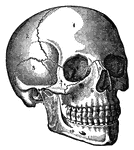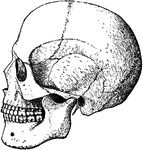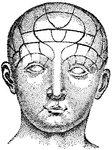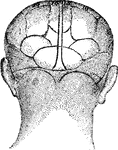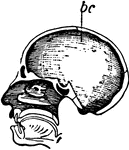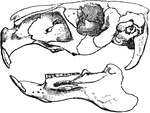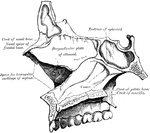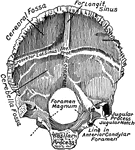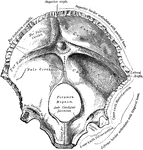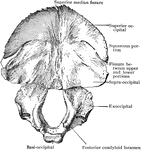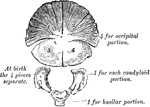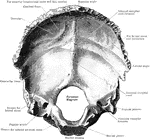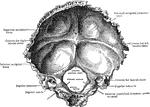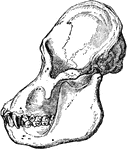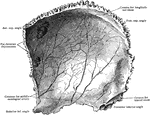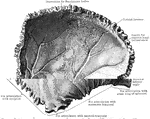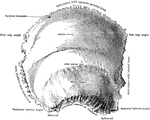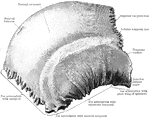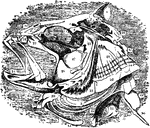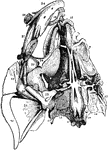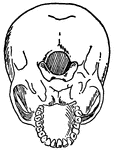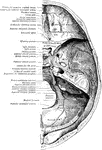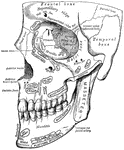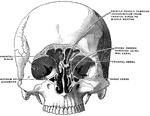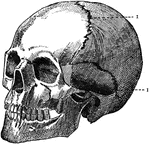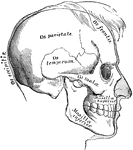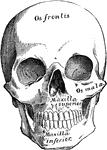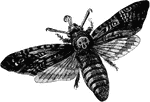
Death's-Head Hawkmoth
This insect is easily identified by the vaguely human skull-shaped pattern of markings on the thorax.
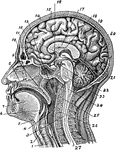
Section of the Head and Neck
Section of head and neck from front to back. Labels: 1, windpipe; 2, larynx; 3, spinal marrow; 4, pharynx;…
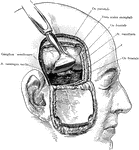
Incision of the Head Showing Gasserian Ganglion
Exposure of the Gasserian ganglion and middle meningeal artery though a flap incision of the scalp and…
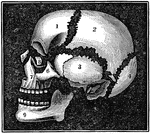
Bones of the Head
A diagram of the bones of the head. Label: 1, frontal lobe; 2, parietal bone; 3, temporal bone; 4, occipital…
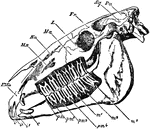
Horse Skull
"Side view of skull of horse, with the bone removed so as to expose the whole of the teeth. PMx, premaxilla;…

Howling Monkey Skull
"Side views of skull and hyoid bone of Howling Money." — Encyclopedia Britanica, 1893

Hydropotes Inermis
"Skull of Hydropotes inermis (adult male), a deer without antlers, but with largely-developed upper…

Hystrix Eristata
"Skull of Hystrix Eristata. t, temporal muscle; m, masseter. m', portion of masseter transmitted through…

Iron Skullcaps from the 16th Century
Two skullcaps used for defense of the head in the 16th century. The caps fit closely to the head. The…
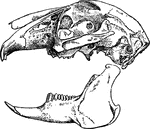
Lepus Timidus
"Terrestril Rodents, with imperfect clavicles, elongated hind limbs, short recurved tail, and long ears.…
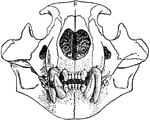
Lion Skull
"The internal structure of the lion, except in slight details, resembles that of the other Felidae,…

Saint Matthew Writing
Saint Matthew sitting an a cloth-covered table writing the Gospel. The Holy Spirit, represented as a…
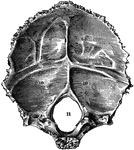
Occipital Bone of the Human Skull
Occipital bone of the human skull, inner surface. It is situated at the back and base of the skull.…

The Skull of a Paddle-Fish with the Beak Removed
"Skull of Spatularia, with the long beak removed, the anterior (asc) and posterior (psc) semicircular…
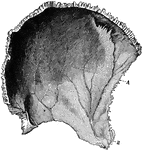
Parietal Bone of the Human Skull
Parietal bone of the human skull, inner surface. The parietal bones form the greater part of the sides…

Polyodon
"Skull of Polyodon. n, nasal cavity; sq, squamosal; mh, hyomandibular; sy, symplectic; pa, palate-pterygold;…

Polypterus Skull
"Upper aspect of the primordial cranium, with the membrane-bones removed. An, angular; ao, anteorbital;…

Polypterus Skull
"Lower aspect of the primordial cranium, with the membrane-bones removed. An, angular; ao, anteorbital;…

Polypterus Skull
"Side view, with the membrane-bones. An, angular; ao, anteorbital; Ar, articulary; B, basal; D, dentary;…

Polypterus Skull
"Lower aspect of the skull, part of the bones being removed on the side. An, angular; ao, anteorbital;…
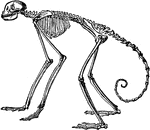
Side View of Skeleton of South American Spider Monkey
"In the other forms the number (vertebrae) varies between twenty and thirty three, the latter being…
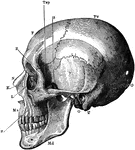
The Skull
A side view of the skull. Labels: O, occipital bone; T, temporal bone; Pr, parietal bone; F, frontal…
